- News
- Reviews
- Bikes
- Components
- Bar tape & grips
- Bottom brackets
- Brake & gear cables
- Brake & STI levers
- Brake pads & spares
- Brakes
- Cassettes & freewheels
- Chains
- Chainsets & chainrings
- Derailleurs - front
- Derailleurs - rear
- Forks
- Gear levers & shifters
- Groupsets
- Handlebars & extensions
- Headsets
- Hubs
- Inner tubes
- Pedals
- Quick releases & skewers
- Saddles
- Seatposts
- Stems
- Wheels
- Tyres
- Tubeless valves
- Accessories
- Accessories - misc
- Computer mounts
- Bags
- Bar ends
- Bike bags & cases
- Bottle cages
- Bottles
- Cameras
- Car racks
- Child seats
- Computers
- Glasses
- GPS units
- Helmets
- Lights - front
- Lights - rear
- Lights - sets
- Locks
- Mirrors
- Mudguards
- Racks
- Pumps & CO2 inflators
- Puncture kits
- Reflectives
- Smart watches
- Stands and racks
- Trailers
- Clothing
- Health, fitness and nutrition
- Tools and workshop
- Miscellaneous
- Buyers Guides
- Features
- Forum
- Recommends
- Podcast
£2,500.00
VERDICT:
Brilliant do-it-all bike. Light, tough, very well-specced and grin-inducing
Weight:
8,730g
Contact:
At road.cc every product is thoroughly tested for as long as it takes to get a proper insight into how well it works. Our reviewers are experienced cyclists that we trust to be objective. While we strive to ensure that opinions expressed are backed up by facts, reviews are by their nature an informed opinion, not a definitive verdict. We don't intentionally try to break anything (except locks) but we do try to look for weak points in any design. The overall score is not just an average of the other scores: it reflects both a product's function and value – with value determined by how a product compares with items of similar spec, quality, and price.
What the road.cc scores meanGood scores are more common than bad, because fortunately good products are more common than bad.
- Exceptional
- Excellent
- Very Good
- Good
- Quite good
- Average
- Not so good
- Poor
- Bad
- Appalling
The Renegade is a brand new model for 2015 from US brand Jamis, tapping into the growing market for adventure road bikes, adept on the road but also capable off it.
As soon as we saw the first details, we set to pestering Evans (which has the exclusive rights to Jamis to the UK) to send us one. Sure enough, we managed to get one of the first examples into the country, and I've spent the last couple of months trying to find the limits of its considerable talents.
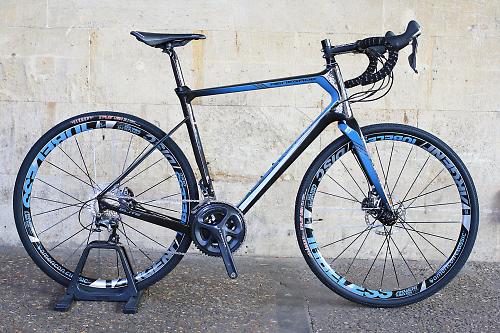
Buy this bike online here
Find your local store here
With an intoxicating combination of road lightness and trail toughness plus Shimano's stunning hydraulic disc brakes and a great wheel and tyre package, the Renegade offers excellent (if relaxed) road manners and is outrageously good fun off the beaten track. It'll go further and harder off-road than any other road bike I've ridden, in fact, with a depth of off-road ability that is simply astonishing. But don't mistake it for a simple mud-plugger with drop bars. A change of tyres is all that's needed to use it for fast all day road rides or even chaingang lung-busters. Leaving no boxes unticked, it also takes mudguards and a rack, and can accommodate tyres up to 40mm. In short, it's an absolute belter.
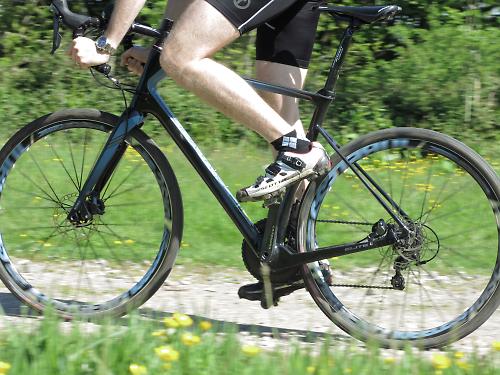
There are two versions of the Renegade – the Elite (which we tested) and the Expert, which – at £1,400 – is over a third less. Neither are what you'd call cheap bikes, but for what you're getting, both are great value. Particularly as – presumably for reasons of currency fluctuation – they are cheaper in the UK than in the US – not something we're accustomed to seeing. We'll be focusing on the Elite version as that's what Evans was kind enough to send us, but we'll look at how the Expert differs too.
Buyers Guide to Disc Braked Road Bikes
Frame and fork
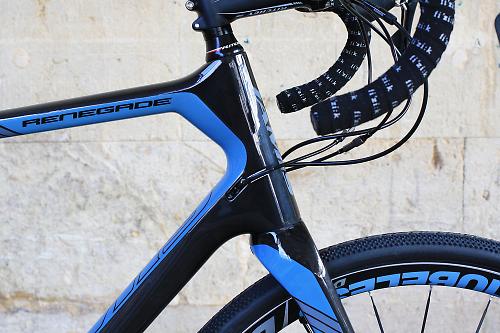
The Renegade Elite has a full carbon monocoque frame and fork, built using high-modulus Omniad M30 carbon fibre and using Jamis's Near Net moulding process. This uses a combination of silicon and polystyrene internal moulding parts to ensure that the inner surface of the monocoque is smooth. Most manufacturers now use similar techniques, with the goal of keeping weight low and strength high through the elimination of any internal stress raisers. The lower-priced Expert model uses a different grade of carbon, (mid-modulus Dyad Plus T700/FRP), resulting in a frame weight that's a little higher than here. Jamis quotes all-up weights of 8.06kg for the smallest Elite and 9.54kg for the equivalent Expert. That's quite a big difference, also attributable to the use of a lower-rung groupset and more basic wheels. Our 58cm Elite weighs a very respectable 8.7kg on the road.cc scales, which is impressive – we've tested several road bikes with disc brakes and no off-road aspirations in the last year which are similar weights.

There are six available frame sizes, from 48 up to 61, with the diameters of the tubes being different from one size to the next – 'Size Specific Tube tuning' – designed to give consistent ride characteristics across the range of sizes. Jamis doesn't stop there, however, also changing the bottom bracket drop and chainstays lengths across the size range. Using three different fork moulds means that Jamis can maintain the desired fork trail despite the head tube angle varying from 70.5 degrees on the 48 up to 72.5 degrees on the 61. Seat tube angle is 73 degrees across all sizes.
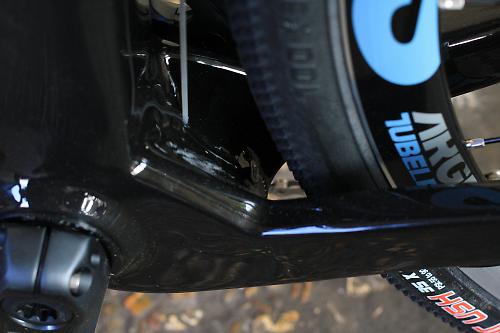
The down tube and top tube are chunky angular sections, and the bottom bracket housing is huge, comfortably swallowing the FSA BB386EVO bearings. Looking rather unusual, the beefy asymmetric chainstays exit markedly below the bottom bracket centre, with this intended to give greater tyre clearance. By contrast the seat stays are fashionably thin and flattened, joining the seat tube a few inches below the junction with the top tube. Jamis says that without the need to mount a brake calliper here, it had greater leeway to tune the compliance in the seat stays without worrying about braking forces.

It works too, with the rear offering a decent level of compliance over bumps and cracks in the road. At the front, the fork uses Rockshox's 15mm Maxle screw-in axle, offset behind the fork legs to provide a small amount of vertical compliance. (There's a standard QR at the rear.) This arrangement is what Jamis calls ECO – Enhanced Compliance Offset. It is less compliant than at the rear, however, with this impression seemingly exaggerated by the rattling of the cables and hydraulic hoses over bumpy terrain. I found this annoying, actually, and used some Jagwire cable clips to stop the racket.
With road tyre pressures, the Renegade doesn't cosset you on bad roads in the same way that a carbon Giant Defy or Trek Domane does, but this is necessarily a burlier machine than either of those. The stock 35mm tyres are a pointed hint that this is a bike that can cope with rather more than a jaunt along a canal path. More on those tyres later.

When I first threw a leg over the Renegade, the impression was of it being quite a large 58. The effective top tube is 586mm, but it's probably the tall front end that contributes most to this impression. Slamming the stem only goes so far; a 202mm headtube and the big tyre clearance meaning that it's no wind-cheater. Aerodynamics are obviously not the primary goal here, and the tall front end is helpful when you're hammering down a rocky bridleway on the drops. Here the long wheelbase helps too – 105cm on the 58 – giving quite exceptional stability.
On the road this makes for handling that is reasonably relaxed – it's certainly not rapier-sharp like a crit bike but neither is it a barge – and off-road it gives you a bit more leeway to push the limits before you run into trouble. One-handed braking, when you need to indicate a turn and you're going too fast to make it round, is supremely unchallenging; less stressful than any other bike I can think of, in fact. The sheer efficiency of the hydraulic brakes undoubtedly helps here too.
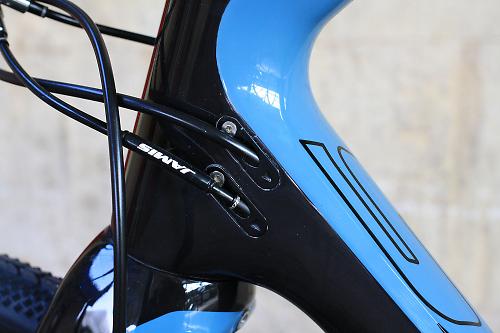
There's full internal cabling on the frame (although the front brake hose doesn't pass inside the fork) and it's Di2 compatible, allowing for future upgrade. There are a couple of other unusual details to point out. The bolts which hold the brake callipers in place screw into perpendicular metal pins which slide into the frame and fork from the side, rather than into fittings moulded into the carbon. Jamis say that this is to remove the risk of in-moulded fittings coming loose when heated by heavy braking. Viewed from the front, the fork legs are noticeably asymmetric, with the lower left leg being thicker in order to deal with the brake forces.
Little metal eyelets screw into the bottom of the fork and the corner between the seatstays and chainstays, allowing mudguards and a rack to be fitted. Apparently some people object to the aesthetic impact of conventional eyelets on a performance bike; I can't say I'm one of them, but the eyelets are a novel solution for those who are concerned by such things.
Fitting a front mudguard can be complicated by the presence of the disc brake – in the end I knocked up a custom bracket to fit much-shortened left stays to the brake calliper mount. The shape of the fork means that the eyelets are below and in front of the axle, so you'll likely need the full length of the wire stays to reach the right-hand mounting point.
At the rear, Jamis tell me that the frame and eyelets were tested with a 25kg load, typically the maximum for all but heavy-duty touring racks. The rack's upper stay has to attach to the tapped hole on the front of the brake bridge, which like the eyelets has to double up if you're also using mudguards. You can buy an adaptor which attaches to the brake bridge and makes rack mounting easier, or you can just do what I did and bend one of the rack's stainless strips to fit.
Equipment - very well thought out selection
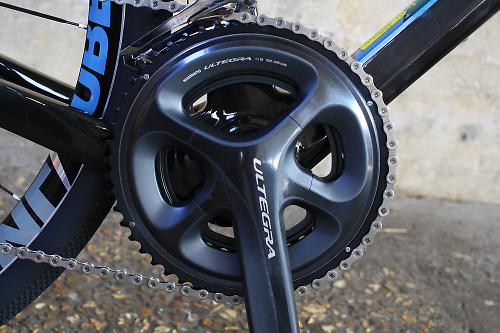
The Renegade Elite is very well kitted out, with a full Shimano Ultegra 22-speed groupset being a decent starting point. There's a wide 11-28 cassette paired with the fashionable pro-compact chainset (52/36), a halfway between a traditional standard chainset and a 50/34 compact. This gives a great spread of gears for road use, but on steep off-road climbs I sometimes found myself wishing for either a 34t chainring, a 32t sprocket or both. Swapping chainrings (to compact or standard sizing) is possible thanks to Shimano now using a common bolt circle diameter between the various sizes. Shimano cranks use a 24mm axle, so Delrin Wheels Mfg adaptors are used to fill the 30mm bearings specified by the press-fit BB386EVO standard.
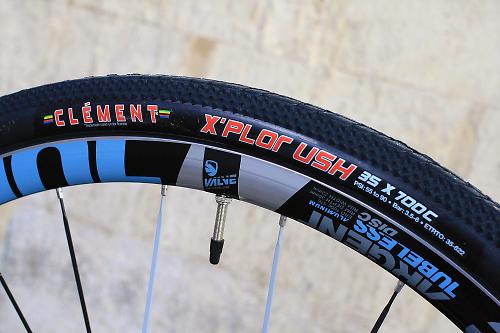
As we've reported previously, Shimano 6800-series Ultegra is a superb groupset, giving slick shifting up and down even under power. When it's my money, I tend to buy SRAM, but I was really impressed with this latest iteration of Ultegra. It's so effortlessly smooth and efficient, with crisp changes at the rear and gloriously lightweight yet precise changes at the front. The otherwise excellent non-series R685 shifters only allow two upshifts at a time at the rear – a constraint of having to package in the hydraulics, we assume.

Besides the frame, one of the key components here is the brakes. We've rhapsodised about Shimano's BR685 discs already, with the clarity and efficiency of hydraulics making controlled braking significantly easier and less tiring than even the best calliper brakes. I used an early Di2 version of these brakes on the road before, and this latest version with the mechanical shifters seems noticeably better dialled in.
On the road, this translates into an intimate relationship between the lever and the brake. Oil gives an effectively frictionless transmission of braking effort, and this makes it easier to judge your braking. Ultimate deceleration is still limited by the grip between your tyres and the road, of course, but being able to apply just the right amount of braking instantly and with this much clarity gives huge confidence when descending at speed. Once you're used to these brakes, getting back onto a rim-braked bike leaves you wondering how you ever thought that was what good braking felt like.

Off road it makes arguably an even greater difference. The power and efficiency of braking available means that one-finger braking is always enough, on any surface, any gradient and at any speed. This liberates the rest of your digits to hang on to the bars and keep the bike going where you want. The front end is directionally very stiff, doubtless enhanced by the fitment of a thru-axle and the tapered headset, and even hitting roots at speed doesn't send it far off-course.
American Classic Argent wheels are another real highlight, with their lightweight toughness suiting the bike perfectly. They're tubeless compatible although the supplied tyres aren't, but it's nice to have the option without changing wheels. The rims are 30mm deep, giving a minor aerodynamic benefit at speed, and they're wide too – 22mm external / 19mm internal, making them a stable platform for wider tyres.

List price on these wheels is a hefty £899 - that's serious money for a £2.5k bike. I couldn't find another similarly-priced adventure road bikes with wheels of remotely this calibre. They're seriously light too, at 1530 grams, with the sub-400g rim weight (yep, less than Mavic Ksyrium Elites) making them quick to accelerate when fitted with road tyres. With the supplied tyres, they've taken a pounding off-road during testing and remained true – very impressive. The wheels are colour-coordinated with the frame and have some rather shouty graphics which will probably divide opinion. In any case these are a fantastic set of wheels (arguably warranting a review all of their own).
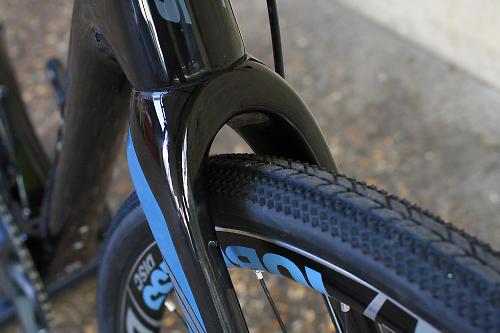
As I mentioned, the tyres aren't tubeless compatible, but they are excellent in most other respects. Jamis opted for the 35mm X-Plor USH model, a 60tpi folding tyre from Clément. Whereas in Mavic-speak UST signifies a tubeless rim design, USH here is the airport code of Ushuaia in Argentina. Of course. All Clément tyres are named after airports, it turns out, and apparently Ushuaia is 'the ultimate destination for adventure bike touring'.
I'll readily admit that I'd expected to switch them out pretty sharpish for something smaller, lighter and more road-focused but they roll surprisingly well on tarmac. The near-continuous centre tread is the key to this, with diamond knobs on the shoulders of the tyres designed to help grip when cornering on loose surfaces. Over the test period I found that there was visible wear on the centre section, so if you're doing high mileage on the road you'd probably want something road-specific. At high pressures they are less supple than some tyres, likely because of the relatively low thread density and the thickness of that central section of rubber.
They're at their best when you drop the pressure, giving loads of compliance from the large air volume; for road use I ran around 50-60psi and used them for rides of 100km or more without feeling they were really slowing me down too much. Off road I went as low as 30psi, with the wide rims helping to keep them stable even at lower pressures. Weighing 350g each, they're not the heaviest 35mm tyres, but obviously there's scope for a decent saving in weight and rotating inertia by fitting road tyres for when you know you'll be staying on the straight and narrow. If you're heading in the other direction, the frame and fork will accommodate up to a 40mm tyre.

The stem, bar, seat-post and saddle are all from Ritchey. The carbon Flexlogic post uses a special layup to add some extra compliance, but it's a chunky 31.6mm post so it doesn't move as much as a thinner one would, and the aluminium Comp bar and stem are relatively low-cost but worked just fine. Fizik's Superlight bar tape is a tough and reasonably comfortable choice, and although I would have opted for something with a bit more padding, this would be easy to remedy.
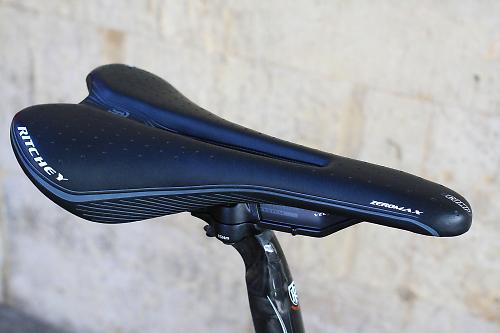
The saddle is the ZeroMax Comp which uses Ritchey's Vector Evo rail mount system. Ritchey says that this moves the mounting points away from the sit-bones to enhance comfort. It's a decent saddle which I got on reasonably well with. If it doesn't suit you, Ritchey can supply clamp adaptors allowing you to fit conventional saddles without needing a whole new seatpost.
Spec Downgrades on the Renegade Expert
The Expert model costs significantly less, and as you'd expect there are some spec downgrades needed to make that possible, as well as the lower-grade carbon used in the frame. Gone are the full hydraulic brakes, although TRP Hy/Rd brakes are the closest you can get with cable actuation. 11-speed Shimano 105 replaces Ultegra, and there's a much lower-cost wheelset with Alex tubeless-compatible rims on Formula hubs. The saddle and seat-post are also downgraded.
Conclusion

Right now, if I had could only have one bike, this would be it. Finding the limits meant taking it to almost ridiculous extremes. Downhilling bridleways with a rack and pannier? Sure – just drop some tyre pressure to maximise grip and revel in the sublime control and braking. Chaingang? Sure, just change the tyres and you'll be fine. Climbing rock-strewn trails? Not a problem, thanks to the low weight and brilliant tyres. Successive long days of touring with a rack? Tick, and in reasonable comfort too.
The frame and fork are brilliantly well-judged, light enough for road use and tough enough to thrive off the beaten track. Shimano's hydraulic brakes are every bit as good as everyone's told you, and the rest of the Shimano bits worked flawlessly. Astutely-chosen tyres and a primo wheelset complete the picture.
The pricing makes this bike terrific value. A lot of the major brands have brought out adventure road bikes this year and none that I've seen are as well-specced for the money. As an example, Specialized has a similar sort of model, the Diverge Expert Carbon, which is $4k in the US and £3k here (with carbon frame, Ultegra, Shimano hydraulics and much more basic wheels). The Jamis is $4.2k in the US and £2.5k here – bargain!
Verdict
Brilliant do-it-all bike. Light, tough, very well-specced and grin-inducing
road.cc test report
Make and model: Jamis Renegade Elite
Size tested: 58 cm
About the bike
State the frame and fork material and method of construction. List the components used to build up the bike.
Carbon monocoque frame and (Maxle) fork. 22 speed Shimano Ultegra with BR685 hydraulic disc brakes. American Classic Argent Tubeless wheelset. Clément X-Plor 35mm tyres. Ritchey finishing kit.
Frame and fork
Overall rating for frame and fork
9/10
Tell us about the build quality and finish of the frame and fork?
Very well finished, sturdy and lightweight.
Tell us about the materials used in the frame and fork?
Omniad M30 Monocoque Carbon Fibre
Tell us about the geometry of the frame and fork?
Relatively tall as befits a bike for on and off-road. 58cm model has 396mm of reach and 620mm of stack, 72° head tube angle, 73° seat tube angle and an effective top tube of 586mm.
How was the bike in terms of height and reach? How did it compare to other bikes of the same stated size?
It felt big initially, although once I'd slammed the stem I was more comfortable.
Riding the bike
Was the bike comfortable to ride? Tell us how you felt about the ride quality.
Comfort was good, especially when running with low tyre pressures (unsurprisingly). The frame and fork don't have the same degree of isolation as bikes such as a carbon Giant Defy or Trek Domane.
Did the bike feel stiff in the right places? Did any part of the bike feel too stiff or too flexible?
Very stiff at the BB for good power transfer. It was quite vertically stiff at the front, but that's a fair price to pay for the abundance of off-road control. Unless you have no interest in ever riding off-road, in which case this maybe isn't the right bike for you.
How did the bike transfer power? Did it feel efficient?
Very efficient – chunky main tubes and a huge BB make this transfer power very well.
Was there any toe-clip overlap with the front wheel? If so, was it a problem?
None – you'd need flippers for this to be a problem with the 105cm wheelbase.
How would you describe the steering? Was it lively, neutral or unresponsive? It is relatively relaxed. This is perfect for the range of use it's designed for and gives tremendous stability. It's not a crit bike.
Tell us some more about the handling. How did the bike feel overall? Did it do particular things well or badly?
Relaxed handling doesn't make it a boring bike – I really enjoyed riding this quickly on the road. Offroad it is simply stunning.
Which components had the most effect (good or bad) on the bike's comfort? would you recommend any changes?
Tyres are probably the biggest contributor together with the frame itself; they're best run at relatively low pressures. I'd fit thicker bar tape.
Which components had the most effect (good or bad) on the bike's stiffness? would you recommend any changes?
Maxle front axle undoubtedly helps and the wheels are excellent in this respect.
Which components had the most effect (good or bad) on the bike's efficiency? would you recommend any changes?
Pedalling efficiency is good, aerodynamic efficiency isn't its strongest suit as it's fairly tall.
Rate the bike for efficiency of power transfer:
9/10
Rate the bike for acceleration:
8/10
Relative to its peers, it accelerates very well. It's obviously no match for a 6kg race bike.
Rate the bike for sprinting:
8/10
Rate the bike for high speed stability:
10/10
Rate the bike for cruising speed stability:
10/10
Rate the bike for low speed stability:
10/10
Rate the bike for flat cornering:
8/10
The big tyres and long wheelbase mean that cornering on the road isn't precise like on a race bike, but with smaller slicks it's good enough.
Rate the bike for cornering on descents:
10/10
I've decided to mark this category primarily for off-road cornering (which doesn't have its own category. I'd give it an 11 if I could.
Rate the bike for climbing:
9/10
Climbs very well on and off road.
The drivetrain
Rate the drivetrain for performance:
10/10
Shimano isn't normally my first choice but Ultegra is basically flawless.
No issues, too soon to give a mark for this I feel.
Rate the drivetrain for weight:
9/10
SRAM Force is lighter, but Ultegra ain't heavy.
Rate the drivetrain for value:
9/10
Full Ultegra with hydraulic discs is great on a bike at this price.
Wheels and tyres
Rate the wheels and tyres for performance:
10/10
Rate the wheels and tyres for durability:
8/10
No brake track to wear out and no trueing needed during testing. Tyres wear quicker than road tyres when used on tarmac.
Rate the wheels and tyres for weight:
10/10
Rate the wheels and tyres for comfort:
8/10
Rate the wheels and tyres for value:
10/10
An £899 wheelset is a pretty unusual sight on a £2500 bike.
Controls
Rate the controls for performance:
9/10
I did find myself wanting to be able to shift 3 at a time at the rear but it wasn't a major irritation. But it's a price I'd happily pay to have those brakes.
Rate the controls for durability:
10/10
No issues.
Rate the controls for weight:
8/10
Rate the controls for comfort:
8/10
Rate the controls for value:
8/10
Tell us some more about the controls. Any particularly good or bad components? How would the controls work for larger or smaller riders?
Brake free travel is spot on – a big improvement from early Di2 hydraulics.
Your summary
Did you enjoy riding the bike? Immensely
Would you consider buying the bike? I am, quite seriously.
Would you recommend the bike to a friend? Absolutely
Rate the bike overall for performance:
10/10
Rate the bike overall for value:
10/10
Anything further to say about the bike in conclusion?
Yes, it's a 10 - some might quibble that there are some niggles - but they are really tiny and easily outweighed by the downright perfection of he overall package. I said I would give it 11 for off-road descending if I could, the same applies to value it really is a fantastic bargain, even more when as I write this Evans have discounted 10 per cent off the list price
About the tester
Age: 36 Height: 190cm Weight: 78kg
I usually ride: Boardman CX team for the daily commute My best bike is: Rose Xeon CRS
I've been riding for: Over 20 years I ride: Most days I would class myself as: Expert
I regularly do the following types of riding: road racing, time trialling, cyclo cross, commuting, touring, club rides, sportives, general fitness riding, fixed/singlespeed, mtb,
Jez spends his days making robots that drive cars but is happiest when on two wheels. His roots are in mountain biking but he spends more time nowadays on the road, occasionally racing but more often just riding.
Latest Comments
- ErnieC 28 min 57 sec ago
or Team Bahrain ... selective outrage.
- newbankgyratory 1 hour 31 min ago
This website offers suitable data: https://www.automobiledimension.com/large-suv-4x4-cars.php
- newbankgyratory 2 hours 4 min ago
Perhaps park the goods in a US Customs Bonded warehouse and then import them out of there when the tariff nonsense settles down?...
- Dnnnnnn 2 sec ago
Good to see a road.cc review of what must be one of the UK's best-selling 'proper' road bikes....
- PRSboy 2 hours 59 min ago
Another thing ruined by the Americans
- Miller 4 hours 18 min ago
Nice to see WvA featuring in the finale.
- Miller 4 hours 20 min ago
I have known more than one elder statesman of the club die of a heart failure while out on a ride. Sometimes I feel that's about to happen to me,...
- Pub bike 4 hours 38 min ago
Via the "wireless active steering system".
- Hirsute 5 hours 2 min ago
137m is the farthest I have observed when quickly looking at the Garmin unit....
- pockstone 5 hours 19 min ago
Yours worked wonders, but if you insist, I'll hop to it...why the need for extra police? Did the fire brigade bottle it?



























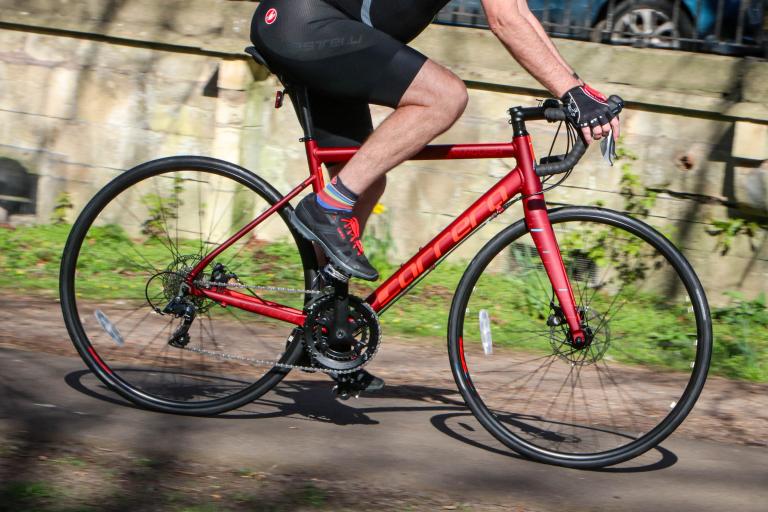



Add new comment
60 comments
Oh indeed. Sorry joules1975, I thought I was being daft enough to not confuse my intent - imagine it in humour tags or similar.
Sorry, meant to delete your quote and only respond to doubledex.
I think there is a certain amount of epoxy resin used to strengthen the frame as carbon would split without it. So there is no such thing as a full carbon bike.
If I had this one I would not use it off road or on gravel tracks. It's a good looking bike. IMO
just to note there are a lot of crap counterfeit allegedly carbon bikes out there. It's a case of buyer beware.
I would not buy a bike from Evans but that's just my choice.
Having just driven from Winchester to Frome and back, I'm just itching to do a 100-mile gravel-and-lanes bash through the plains. My 28c Schwalbe One tubeless would probably handle it fine, but this bike sounds like it would take enjoyment and speed to a whole new level.
I rode my reasonbly new GT Grade 'gravel bike' around Llangollen/ World's End/ Horsehoe Pass on Saturday. My buddy was on a Boardman aero machine with 23mm tyres and caliper brakes.
On the gravelly country roads, canal paths, and damp dappled descents I felt a great deal more comfortable and in control. On the road sections despite being heavier and less aero I didn't notice much difference between the GT and my Planet X Pro Carbon.
Essentially, there was no surface or route that the bike couldn't handle. I will no longer look down side roads and think "maybe not..".
And as for the disc brake debate- each to their own, but one finger braking on steep descents is a revelation, and ultimately allows you to go faster knowing you can slow/ stop quicker and easier... in my opinion.
I did manage to come off at one point and get a bit of road rash but that was purely operator error!
That may be because if your planet X is anything like the planet X bikes I've seen, a fair amount of you energy will be disappearing into frame flex.
Flexible frames don't make energy disappear.
No, but theoretically the flexing of the frame will cause it to heat up, which is where the energy will end up... But I doubt the effect is appreciable in the real world.
Maybe the words 'energy' and 'disappearing' were the wrong ones to use, but the more the bike flexes, the less of your effort gets through to rotating the rear wheel. Simple principle really, cause if some of the force you put into the pedals is being used to flex the frame (or indeed anything else on the bike), that means less is being translated into forward propulsion.
Don't take my word for that, look at the likes of Giant, who openly admit that their Propel is not as stiff as the TCR or Defy, and therefore not quite as efficient at translating pedaling into forward propulsion, but they believe the aero advantages outweigh this issue when ridden flat out on the flat. On hilly routes though the TCR or Defy are better options.
During flex the energy is first stored then returned with almost no losses so the same number of watts will be transferred to the rear wheel regardless of the frame stiffness. The only difference will be the feel. Bikes that feel fast, sell better
Sorry, but It's been a while since I played around in the lab during my engineering degree, so have to bow to you on whether energy is returned during flex, but I don't see how a sideways flex in the frame would translate back into a forward pull on the chain.
Also, if lateral stiffness didn't matter, why is a laterally stiff but vertically compliment frame the holy grail for the entire bike industry?
That said, I may need to change my views on how frame stiffness affects efficiency as I've just found this.
https://janheine.wordpress.com/2011/10/03/science-and-bicycles-frame-sti...
Very interesting. And would back up what you were implying. I'd still prefer laterally stiff frame with regards handling though.
With the amount of surface dressing that Bradford council are doing at the moment this is going to be perfect.
A genuine question: what kind of rides would someone use these gravel bikes on? If its single track then wouldn't a hardtail mountain bike be better suited? If it's country lanes then wouldn't a road bike be better? I can get the idea behind riding these bikes in countries that have large swathes of loose gravel road, but do we have that here?
I know we don't have the network of gravel roads they have in the states for example. However, a bike with this degree of flexibility is very usable for UK conditions I feel. We do have an extensive network of bridleways, forestry commission fire roads, and now an increasing number of windfarm access roads, not to mention sustrans routes. Often these are not enough to make a ride on their own, but can be linked together with tarmac'ed routes to make very interesting rides. The fact this bike seems to able to handle this sort of thing with very little compromise on the road makes it very attractive for me.
I know we don't have the network of gravel roads they have in the states for example. However, a bike with this degree of flexibility is very usable for UK conditions I feel. We do have an extensive network of bridleways, forestry commission fire roads, and now an increasing number of windfarm access roads, not to mention sustrans routes. Often these are not enough to make a ride on their own, but can be linked together with tarmac'ed routes to make very interesting rides. The fact this bike seems to able to handle this sort of thing with very little compromise on the road makes it very attractive for me.
Erm, yes we do have that sort or riding here, just look at most of Wales, and a large chunk of Southern Scotland, plus any areas that have some forests or smoothish offroad double track in them (Nottinghamshire, Cannock, Northumberland, etc, etc.), plus anywhere that has canal towpaths or old railway lines converted into gravel paths, which covers most of the southern part of the UK.
Basically, these bikes are great for 'mixing it up'. OK you might not be able to have a 100 mile 100% gravel sportive in the UK without having a seriously wiggly route that's at risk of crossing itself, but a road ride with off-road 'shortcuts' ... loads of options.
Get a map of britain - won't take you long to find stuff this kind of bike would be great for.
Bikes like that are for people who understand the benefits of wider tyres (and the concept of pneumatic tyres in general ;-)for commuting/training and other types of of non-competitive cycling on UK roads and cycle lanes.
When you try some high end wide (32mm or wider) rubber and realize that you can be as fast or faster on most of the rides, you'll appreciate the benefits.
One day bikes like that will be called err...
road bikes...
Totally this.
This is the type of bike I've always wanted; one bike to do it all. Finally one that has clearance for big tyres and that also has rack mounts. A spare set of wheels with road tyres on for the fast rides and that's two to four bikes (Road, CX, Tourer, Winter) distilled into one. This and a 150mm travel MTB and I reckon you could get 6 bikes down to 2!
I agree. I did exactly that. I sold my 'road bike' (in quotes because as you say, its such a broad term) and my CX bike and looked at the renegade elite, but went for the GT Grade carbon in the end as I felt it was MUCH nicer; the renegade was a bit ugly and some of the kit choices were odd. Anyway, the GT is notably faster in every area than my old, dedicated road bike. It does everything I need with no compromises.
Shame Evans has the exclusive, this would be on the shortlist* for Xmas otherwise.
(*Grade, Domane, Roubaix)
Why would them having it stop you wanting it to get it ? Do you a particularly awful local Evans ? Whatever, I don't think they accompany the bike the whole time after they sell it or tweak it somehow to make it suddenly shite... fairly sure it'll be the same bike being reviewed here.
Because I refuse to give money (and enhance their profits, even by a miniscule amount) to a shop - or in this case, chain - who have provided me with sh!t service, and then not bothered one bit to address that. That goes for both branches in Glasgow. My oppo has just had a similar experience, ironically when he had ordered a Jamis MTB.
So shit experience in the past from them, fair enough, hence the question. Personally if the bike really warrantied it, which this is nudging toward for me, I couldn't give a damn about the service unless actively offensive but as you have history with them and several alternatives (all of which look great) then it's probably more important. Your money, your choice.
From personal experience, even the aluminium Domane was superb on the lanes and small lumpy stuff, fatish rubber or tubeless on Bontrager Race rims - great laugh.
That's really expensive.
What? How is that expensive? Seems like a more than decent price actually.
Based on this review I'd happily try one, if it wasn't so horrifyingly ugly. A frame only a mother could love.
+1 for the ugliness factor. I'd never buy a frame with a press fit BB, and Rule 60 applies.
What? How is that expensive? Seems like a more than decent price actually.
Based on this review I'd happily try one, if it wasn't so horrifyingly ugly. A frame only a mother could love.[/quote]
How is that is expensive? we havent all got 2 fucking thousand quid thats why its fucking expensive you rEtarded stuck up CUNT
Its £2,250 at the moment.
" the front brake hose doesn't pass inside the fork"
I was 100% about to order this bike.
Then that.
...Nah seriously, I think that's my next ride. Stupendous. Great review Jez.
What we need now is a road.cc compo to win one
Pages